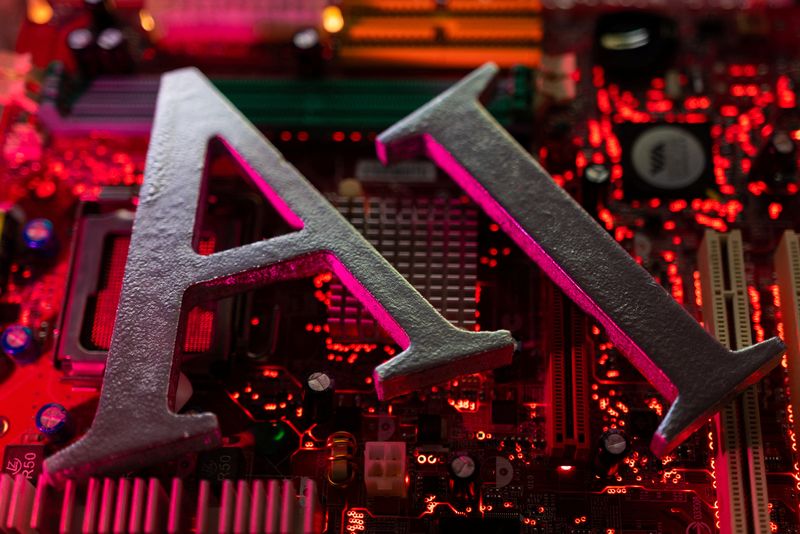By Jamie McGeever
ORLANDO, Florida (Reuters) -The shine may finally be coming off AI.
If so, the rotation out of Big Tech into small caps that has emerged recently could quickly accelerate. The question then is whether outperforming laggards hold up the broader market, or does the AI selloff drive benchmark indices into the red?
Another round of upbeat results and outlooks from the second-quarter earnings season will reinvigorate the bull case for all things related to artificial intelligence and microchips.
But failure to meet elevated expectations leaves the "Magnificent Seven" stocks, which make up a third of the S&P 500's market cap and are responsible for around two-thirds of the S&P 500's entire gains this year, highly exposed.
Throw in the potential escalation of U.S.-China trade wars in a possible Trump presidency that will, on balance, benefit U.S.-based small cap firms, and you get a glimpse of how this might play out.
Last Friday the Magnificent Seven ETF, which includes semiconductor chip maker Nvidia (NASDAQ:NVDA), tumbled 4.4%, the biggest fall since its launch in April 2023. The Russell 2000 index of small cap stocks had its largest one-day risk-adjusted rally in history and its third-largest outperformance versus the Nasdaq, according to a Bank of America analysis.
Since the release of surprisingly soft U.S. inflation data on July 10, the Russell 2000 is up 10% and the 'Mag Seven' ETF and NYSE FANG index, which includes the Mag Seven stocks, are both down more than 5%. The S&P 500 is now in the red too.
Like the Emperor's new clothes, questions about whether AI really is all it is cracked up to be are now being asked.
Daron Acemoglu, a professor of economics at the Massachusetts Institute of Technology, wrote an article in May titled "Don't Believe the AI Hype", a pithier follow-up to an extensive research paper he penned earlier that month titled "The Simple Macroeconomics of AI."
Acemoglu argues that the estimated "total factor productivity" impact over the next decade of AI technology, in its current guise at least, is a relatively tiny 0.53%. That's a negligible 0.05% a year.
His forecasts for around 0.5% and 1% increases in AI-generated productivity and GDP growth, respectively, over the next 10 years are significantly lower than Goldman Sachs economists' comparable estimates of around 9% and 6%.
PLENTY COST, LITTLE BENEFIT
Acemoglu's thoughts and findings were included in a June 25 note from Goldman Sachs "Gen AI: Too much spend, too little benefit?" that dissected the pros and cons of AI.
Jim Covello, head of global equity research at the investment bank, is far more skeptical than his colleagues on the economics team.
Covello reckons investment in expanding AI infrastructure - on data centers, utilities, and applications, among other things - will exceed $1 trillion in coming years. The crucial question, in Covello's view, is: what $1 trillion problem will AI solve?
"Replacing low-wage jobs with tremendously costly technology is basically the polar opposite of the prior technology transitions I've witnessed in my thirty years of closely following the tech industry," he says.
Comparisons with the early days of the internet are misplaced. Even in its infancy the internet was a low-cost technology solution that enabled e-commerce to replace costly existing structures - quite literally - such as brick-and-mortar buildings.
Covello gives the example of integrating GPS into smartphones. The technology for this to be rolled out widely didn't exist in the early 2000s but - no pun intended - the "roadmap" did. The roadmap on what other technologies could eventually deliver was also there right at the start.
Is that the case today with AI? "Eighteen months after the introduction of generative AI to the world, not one truly transformative - let alone cost-effective - application has been found," he argues.
NO GAME CHANGER
Covello's is one of the few voices on Wall Street to call out the AI mania so bluntly. Bob Elliott, the CEO at Unlimited Funds and a former executive at Bridgewater, this week added his.
Even in the most optimistic scenario, Elliott says the benefits to S&P 500 companies from rising AI-related spending and increased economy-wide productivity are "modest."
That scenario assumes a $1.3 trillion rise in AI spending through 2032, all by S&P 500 companies, lifting revenue growth to around 6.5% from 4%. Added together, he reckons this implies a roughly $650 billion increase in S&P 500 earnings by 2032 relative to today, or about a 25% increase in nominal terms.
Even if you ignore the difficulty in forecasting earnings eight years out, that points to around a $10 trillion, or 25%, increase, on the S&P 500's current market cap.
"It's a pretty marginal impact, not one that is game changing ... (and) is already likely priced in ... probably fully priced last year during the summer of the AI 'boom,'" Elliott posted on X this week.
Investors may be slowly coming round to this view. Bank of America's July fund manager survey shows that 43% of respondents now think AI is in a bubble, up five percentage points from May, while 45% don't think so, down from more than 50% in May.

But nothing changes sentiment like price, and it will probably take a much bigger reversal in these overcrowded trades to convince investors that the AI well has run dry.
(The opinions expressed here are those of the author, a columnist for Reuters.)
(By Jamie McGeever; Editing by Paul Simao)